| Listing 1 - 10 of 15 | << page >> |
Sort by
|
Book
ISBN: 2130429998 9782130429999 Year: 1990 Volume: 2526 Publisher: Paris : Presses universitaires de France,
Abstract | Keywords | Export | Availability | Bookmark
 Loading...
Loading...Choose an application
- Reference Manager
- EndNote
- RefWorks (Direct export to RefWorks)
Hebrew literature --- Thematology --- Rabbinical literature --- Littérature rabbinique --- 296*1 --- 296.1 --- Hebreeuwse bijbel: targum; midrasj; bijbelcommentaren; haggadische verzamelingen--(algemeen) --- Judaism --- Rabbinical literature. --- Doctrines. --- 296*1 Hebreeuwse bijbel: targum; midrasj; bijbelcommentaren; haggadische verzamelingen--(algemeen) --- Littérature rabbinique
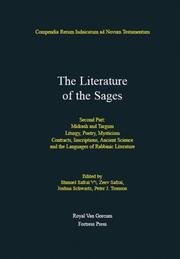
ISBN: 902324222X 9789023242222 080060606X 9780800606060 9004275126 9789004275126 Year: 2006 Volume: 3b Publisher: AssenPhiladelphia Royal Van Gorcum ;Fortress Press
Abstract | Keywords | Export | Availability | Bookmark
 Loading...
Loading...Choose an application
- Reference Manager
- EndNote
- RefWorks (Direct export to RefWorks)
This long-awaited companion volume to The Literature of the Sages , First Part (Fortress Press, 1987) brings to completion Section II of the renowned Compendia series. The Literature of the Sages, Second Part, explores the literary creation of thousands of ancient Jewish teachers, the often- anonymous Sages of late antiquity and the Middle Ages. Essays by premier scholars provide a careful and succinct analysis of the content and character of various documents, their textual and literary forms, with particular attention to the ongoing discovery and publication of new textual material. Incorporating groundbreaking developments in research, these essays give a comprehensive presentation published here for the first time. This volume will prove an important reference work for all students of ancient Judaism, the origins of Jewish tradition, and the Jewish background of Christianity. The literary creation of the ancient Jewish teachers or Sages – also called rabbinic literature – consists of the teachings of thousands of Sages, many of them anonymous. For a long period, their teachings existed orally, which implied a great deal of flexibility in arrangement and form. Only gradually, as parts of this amorphous oral tradition became fixed, was the literature written down, a process that began in the third century C.E. and continued into the Middle Ages. Thus the documents of rabbinic literature are the result of a remarkably long and complex process of creation and editing. This long-awaited companion volume to 'The Literature of the Sages, First Part' (1987) gives a careful and succinct analysis both of the content and specific nature of the various documents, and of their textual and literary forms, paying special attention to the continuing discovery and publication of new textual material. Incorporating ground-breaking developments in research, these essays give a comprehensive presentation published here for the first time. 'The Literature of the Sages, Second Part' is an important reference work for all students of ancient Judaism, as well as for those interested in the origins of Jewish tradition and the Jewish background of Christianity.
Jewish religion --- Jewish religious literature --- History and criticism. --- Judaïsme --- 296*1 --- Hebreeuwse bijbel: targum; midrasj; bijbelcommentaren; haggadische verzamelingen--(algemeen) --- Rabbinical literature --- 296*1 Hebreeuwse bijbel: targum; midrasj; bijbelcommentaren; haggadische verzamelingen--(algemeen) --- History and criticism --- Jewish religious literature. --- Rabbinical literature. --- Hebrew literature --- Jewish literature --- Religious literature, Jewish --- Religious literature --- Jewish religious literature - History and criticism
Book
ISBN: 9782503553061 2503553060 Year: 2015 Volume: 4 Publisher: Turnhout: Brepols,
Abstract | Keywords | Export | Availability | Bookmark
 Loading...
Loading...Choose an application
- Reference Manager
- EndNote
- RefWorks (Direct export to RefWorks)
Ben Sira prétendait que Siméon le Juste avait « fondé la double hauteur » de la Bible. Il entendait par là que, derrière le sens apparent de la narration biblique, le Grand Prêtre avait codé un sens allégorique que seuls les initiés pouvaient connaître, un sens caché conservé intact jusqu’à aujourd’hui. Les Evangélistes se souvenaient d’un vieillard nommé Siméon, qui était juste et qui devait attendre, aussi longtemps qu’il le faudrait, la venue du Sauveur annoncé par les Écritures. Lorsqu’il vit Jésus, il sut que cette attente interminable prenait fin, attesta que Jésus était bien ce Sauveur et demanda au Seigneur de le rappeler enfin à lui. Les Juifs se souvenaient également d’un personnage nommé Siméon le Juste. Pendant la première partie de sa vie il avait fait partie de la Grande Assemblée où siégeaient les derniers prophètes et avait parlé d’une seule voix avec eux, puis il s’était laissé séduire par les beautés de l’hellénisme, ce qui lui avait valu de mourir à la moitié de ses jours. Par des biais différents, Juifs et Chrétiens s’accordaient à faire de ce Siméon de légende le symbole d’un passé révolu. Derrière la légende se cache l’histoire d’un grand prêtre de la période hellénistique, Siméon fils d’Onias. Sa famille, originaire d’Egypte, avait obtenu des rois grecs d’Alexandrie la charge héréditaire de grand prêtre du Temple de Jérusalem, une charge que Siméon occupa de 220 à 195 avant notre ère. Pour Jésus ben Sira, son contemporain, il avait été, avant tout, celui qui «avait fondé la double hauteur», ce qui signifiait qu’il avait doublé le sens superficiel de la Bible hébraïque d’un sens allégorique caché sous les lettres même de l’Écriture. Aussi improbable que puisse nous paraître une telle thèse, elle méritait d’être vérifiée. Et effectivement, ce monument «à double hauteur» enfoui sous les alluvions de plus de vingt siècles d’histoire de l’interprétation du texte biblique est demeuré intact.
Simeon --- Bible --- Criticism, interpretation, etc --- 296*1 --- 296*1 Hebreeuwse bijbel: targum; midrasj; bijbelcommentaren; haggadische verzamelingen--(algemeen) --- Hebreeuwse bijbel: targum; midrasj; bijbelcommentaren; haggadische verzamelingen--(algemeen) --- Simon le Juste --- Simon le Juste (20 av. J.-C.?-20 av. J.-C.?) --- Critique, interprétation, etc. --- Critique et exégèse.
Book
ISBN: 0521242487 0521285534 0511607601 Year: 1988 Volume: vol 4 Publisher: Cambridge New York Sydney Cambridge University Press
Abstract | Keywords | Export | Availability | Bookmark
 Loading...
Loading...Choose an application
- Reference Manager
- EndNote
- RefWorks (Direct export to RefWorks)
Rabbinic texts are often cited in New Testament and Old Testament studies, but hitherto there has been no easy way for a student to grasp the scope and variety of the relevant rabbinic writings. This book introduces the student to the full range of the early rabbinic writings, with a thorough introduction and notes, so that both a bird's eye view of the literature as well as close aquaintance with typical and important texts can be obtained. This will enable the reader to embark on further study with a clearer orientation. The book also aims to correct many mistaken views about rabbinic Judaism arising from outdated conceptions of the relation between Christianity and Judaism.
Godsdienst [Joodse ] --- Jewish religion --- Jews--Religion --- Joden--Godsdienst --- Jodendom --- Joodse godsdienst --- Judaism --- Judaïsme --- Juifs--Religion --- Religion [Jewish ] --- Religion juive --- 296*1 --- Rabbinical literature --- -Rabbinical literature --- -#GOSA:XV.Jod.O --- #GOSA:XV.Jod.M --- Hebrew literature --- Jewish literature --- Hebreeuwse bijbel: targum; midrasj; bijbelcommentaren; haggadische verzamelingen--(algemeen) --- History and criticism --- Translations into English --- 296*1 Hebreeuwse bijbel: targum; midrasj; bijbelcommentaren; haggadische verzamelingen--(algemeen) --- #GOSA:XV.Jod.O --- Arts and Humanities --- Religion --- History and criticism.
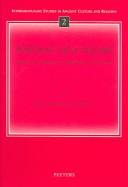
ISBN: 904291033X 9789042910331 Year: 2002 Volume: 2 Publisher: Leuven: Peeters,
Abstract | Keywords | Export | Availability | Bookmark
 Loading...
Loading...Choose an application
- Reference Manager
- EndNote
- RefWorks (Direct export to RefWorks)
Laban (Biblical figure) in rabbinical literature. --- Midrash --- Villains in rabbinical literature. --- Villains in rabbinical literature --- History and criticism. --- Laban --- In rabbinical literature --- Bible --- Versions --- Targum Pseudo-Jonathan --- 222.4 --- 296*1 --- Deuteronomium --- Hebreeuwse bijbel: targum; midrasj; bijbelcommentaren; haggadische verzamelingen--(algemeen) --- 296*1 Hebreeuwse bijbel: targum; midrasj; bijbelcommentaren; haggadische verzamelingen--(algemeen) --- Rabbinical literature --- History and criticism --- Laban, --- Lavan --- In rabbinical literature. --- Bible. --- Targum Pseudo-Jonathan. --- Midrash - History and criticism. --- Laban - (Biblical figure) - In rabbinical literature --- Laban - (Biblical figure)
Book
ISBN: 1555406971 Year: 1992 Volume: vol 42 Publisher: Atlanta, Ga. Scholars Press
Abstract | Keywords | Export | Availability | Bookmark
 Loading...
Loading...Choose an application
- Reference Manager
- EndNote
- RefWorks (Direct export to RefWorks)
Opstanding (Joodse theologie) --- Resurrection (Jewish theology) --- Résurrection (Théologie juive) --- 296*1 --- Hebreeuwse bijbel: targum; midrasj; bijbelcommentaren; haggadische verzamelingen--(algemeen) --- 296*1 Hebreeuwse bijbel: targum; midrasj; bijbelcommentaren; haggadische verzamelingen--(algemeen) --- Talmud. --- Sanhedrin (Talmud) --- Sanedrín (Talmud) --- Berakot (Talmud) --- Berakhot (Talmud) --- Berajot (Talmud) --- Berakhos (Talmud) --- Berakoth (Talmud) --- Bava meẓia (Talmud) --- Baba meẓiʻa (Talmud) --- Bava metsiʻa (Talmud) --- Bava metzia (Talmud) --- Baba metsía (Talmud) --- Criticism, interpretation, etc. --- Talmud. Bava mezia --- Criticism, interpretation, etc --- Talmud. Berakhot --- Talmud. Sanhedrin --- Talmud. Bava me zia - Criticism, interpretation, etc. --- Talmud. Berakhot - Criticism, interpretation, etc. --- Talmud. Sanhedrin - Criticism, interpretation, etc.
Book
ISBN: 9789004348912 9004348913 9789004348929 9004348921 Year: 2017 Volume: 56 Publisher: Leiden ;Boston Brill
Abstract | Keywords | Export | Availability | Bookmark
 Loading...
Loading...Choose an application
- Reference Manager
- EndNote
- RefWorks (Direct export to RefWorks)
In Jethro and the Jews , Beatrice J. W. Lawrence examines rabbinic texts that address the biblical character of Jethro, a Midianite priest, Moses’ advisor and father-in-law, and the creator of the system of Jewish jurisprudence. Lawrence explores biblical interpretations in Midrash, Targum and Talmud, revealing a spectrum of responses to the presence of a man who straddles the line between insider and outsider. Ranging from character assassination to valorization of Jethro as a convert, these interpretive strategies reveal him to be a locus of anxiety for the rabbis concerning conversion, community boundaries, intermarriage, and non-Jews.
296*1 --- 296*1 Hebreeuwse bijbel: targum; midrasj; bijbelcommentaren; haggadische verzamelingen--(algemeen) --- Hebreeuwse bijbel: targum; midrasj; bijbelcommentaren; haggadische verzamelingen--(algemeen) --- Rabbinical literature --- Jews --- Identity, Jewish --- Jewish identity --- Jewishness --- Jewish law --- Jewish nationalism --- History and criticism. --- Identity. --- Ethnic identity --- Race identity --- Legal status, laws, etc. --- Jethro --- Hobab --- Ḥovav --- Jether --- Raguel --- Reuel --- Yeter --- Yitro --- Bible. --- Chumash --- Five Books of Moses --- Ḥamishah ḥumshe Torah --- Ḥumash --- Kitāb-i Muqqadas --- Mose Ogyŏng (Book of the Old Testament) --- Pentateuch --- Pi︠a︡toknizhīe Moiseevo --- Sefer Ḥamishah ḥumshe Torah --- Tawrāh --- Torà (Pentateuch) --- Torah (Pentateuch) --- Tʻoris xutʻcigneuli --- Ureta --- תורה --- Haftarot --- Criticism, interpretation, etc., Jewish.
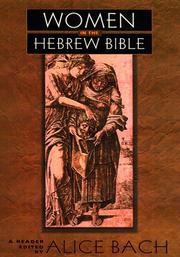
ISBN: 0415915619 9780415915618 0415915600 9780415915601 Year: 1999 Publisher: New York: Routledge,
Abstract | Keywords | Export | Availability | Bookmark
 Loading...
Loading...Choose an application
- Reference Manager
- EndNote
- RefWorks (Direct export to RefWorks)
Deze publicaties brengt een aantal essays bij elkaar over de rol van vrouwen in het Oude Testament. De auteurs onderzoeken de houding tegenover vrouwen en hun status in de maatschappij van het oude Nabije-Oosten,, met een focus op de Israëlische samenleving zoals die in de Bijbel verbeeld wordt. De onderwerpen gaan van feministische strategieën om de sociale wereld ten tijde van de productie van de Bijbel te begrijpen tot interpretaties van belangrijke literaire vrouwelijke figuren als Ruth, Esther, Judith, Sarah, Rachel en Leah.
Bible--Femmes --- Bible--Women --- Bijbel--Vrouwen --- Femmes dans la Bible --- Moeders--Bijbelleer --- Mothers--Biblical teaching --- Mères--Enseignement biblique --- Vrouwen in de Bijbel --- Women in the Bible --- Bible --- Jewish religion --- Sociology of the family. Sociology of sexuality --- Religious studies --- Bible OT --- Bible. Old Testament --- Criticism, interpretation, etc --- Feminist criticism --- T. --- Criticism, interpretation, etc. --- Feminist criticism. --- Women in the Bible 22-055.2 --- 22-055.2 --- 296*1 --- 296*1 Hebreeuwse bijbel: targum; midrasj; bijbelcommentaren; haggadische verzamelingen--(algemeen) --- Hebreeuwse bijbel: targum; midrasj; bijbelcommentaren; haggadische verzamelingen--(algemeen) --- 22-055.2 Vrouwen in de bijbel --- Vrouwen in de bijbel --- Religious texts --- Judaism --- Images of women --- Book
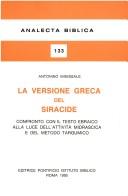
ISBN: 8876531335 9788876531330 Year: 1995 Volume: 133 Publisher: Roma: Pontificio Istituto Biblico,
Abstract | Keywords | Export | Availability | Bookmark
 Loading...
Loading...Choose an application
- Reference Manager
- EndNote
- RefWorks (Direct export to RefWorks)
Bible --- Versions --- Translating --- 221.014*2 --- 296*1 --- Oud Testament: geschiedenis van grondtekst en oude vertalingen --- Hebreeuwse bijbel: targum; midrasj; bijbelcommentaren; haggadische verzamelingen--(algemeen) --- Theses --- 296*1 Hebreeuwse bijbel: targum; midrasj; bijbelcommentaren; haggadische verzamelingen--(algemeen) --- 221.014*2 Oud Testament: geschiedenis van grondtekst en oude vertalingen --- Bible. --- Ben Sira (Book of the Apocrypha) --- Book of Ben Sira (Book of the Apocrypha) --- Book of Sirach (Book of the Apocrypha) --- Ecclesiasticus (Book of the Apocrypha) --- Ḥokhmat Shimʻon ben Sira (Book of the Apocrypha) --- Ḥokhmat Yehoshuʻa ben Sira (Book of the Apocrypha) --- Jesus Sirach (Book of the Apocrypha) --- Sefer Ben Sira (Book of the Apocrypha) --- Sefer Ḥokhmat Yehoshuʻa ben Sira (Book of the Apocrypha) --- Sirach (Book of the Apocrypha) --- Sirachbuch (Book of the Apocrypha) --- Wisdom of Ben Sira (Book of the Apocrypha) --- Wisdom of Jesus the Son of Sirach (Book of the Apocrypha) --- Wisdom of Sirach (Book of the Apocrypha) --- Words of Simeon ben Jeshua (Book of the Apocrypha) --- Translating. --- Versions.
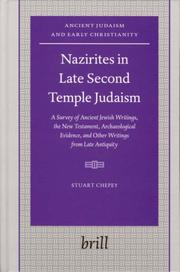
ISBN: 900414465X 9786610868797 1429453516 9047407873 1280868791 1433704579 9789004144651 9781429453516 9781433704574 9781280868795 6610868794 9789047407874 Year: 2005 Volume: 60 Publisher: Leiden ; Boston : Brill,
Abstract | Keywords | Export | Availability | Bookmark
 Loading...
Loading...Choose an application
- Reference Manager
- EndNote
- RefWorks (Direct export to RefWorks)
Nazirites appear in a number of sources relevant to Judaism of the late Second Temple period. This book surveys the pertinent evidence and assesses what it reveals regarding the role of the Nazirite within Judaism of the late Second Temple and early Christian era. The survey is arranged according to three primary sections: “Direct Evidence for Nazirites”; “Possible and Tangential Evidence for Nazirites”; and a final section, “Making Sense of the Evidence.” It concludes by arguing that the role of the Nazirite portrayed in sources was that of a religious devotee, and concomitant with biblical law, Nazirite devotion typically involved flexibility, personal freedom of expression, and adaptation to outside cultural norms. Those interested in the Nazirite vow as portrayed in the New Testament and other relevant sources will find this study useful, as will those interested in Bible translation and interpretation in late Second Temple and early rabbinic literature.
Nazarite (Judaism) --- Judaism --- Vows in rabbinical literature. --- Rabbinical literature --- Vows in the Bible. --- History --- History and criticism. --- 296*1 --- 296*72 --- 296*72 Joodse sekten en stromingen in de nabijbelse tijd: Karaïten--bv. --- Joodse sekten en stromingen in de nabijbelse tijd: Karaïten--bv. --- 296*1 Hebreeuwse bijbel: targum; midrasj; bijbelcommentaren; haggadische verzamelingen--(algemeen) --- Hebreeuwse bijbel: targum; midrasj; bijbelcommentaren; haggadische verzamelingen--(algemeen) --- Vows in rabbinical literature --- Vows in the Bible --- Nazirite (Judaism) --- Hellenistic Judaism --- Judaism, Hellenistic --- History and criticism --- Joodse sekten en stromingen in de nabijbelse tijd: Karaïten--bv --- Bible. --- Ba-yon Tipan --- Bagong Tipan --- Jaji ma Hungi --- Kainē Diathēkē --- New Testament --- Nouveau Testament --- Novo Testamento --- Novum Testamentum --- Novyĭ Zavet --- Novyĭ Zavi︠e︡t Gospoda nashego Īisusa Khrista --- Novyĭ Zavit --- Nuevo Testamento --- Nuovo Testamento --- Nye Testamente --- Perjanjian Baru --- Dhamma sacʻ kyamʻʺ --- Injīl --- Criticism, interpretation, etc. --- Judaism - History - Post-exilic period, 586 B.C.-210 A.D. --- Rabbinical literature - History and criticism.
| Listing 1 - 10 of 15 | << page >> |
Sort by
|

 Search
Search Feedback
Feedback About UniCat
About UniCat  Help
Help News
News